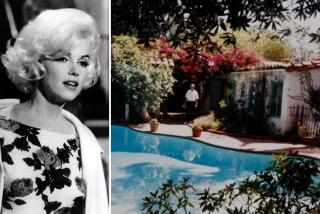Searching for Traces of James Madison : Montpelier: Conservationists hope to restore the residence of the fourth President. But hints of his life are elusive; the home was extensively redone by the DuPonts.
- Share via
ORANGE, Va. — In the room where James Madison’s parents lived, Larry Dermody studied the two puzzling shadows on the ceiling.
There might have been a partition there, where nobody ever thought there was one.
“We are going to be exploring that area next,” he says.
Dermody, an architectural conservator, is part of a team engaged in what he and his colleagues call the search for James Madison at Montpelier, the home of the fourth president and his family.
The search will take a while.
Montpelier, the most recently opened of the National Trust for Historic Preservation’s 17 house museums, is not like the exquisitely kept Woodlawn Plantation at Mt. Vernon or the memorabilia-laden Woodrow Wilson house in Washington.
In most of the rooms the Madisons lived in, there is no furniture. Outside, the stucco is peeling from the brick walls. The mansion’s enormous copper roof needs to be replaced.
“People are not happy to see a president’s home in the state that the house is in,” says Atwell Somerville, member and former chairman of the Montpelier Property Council, a mainly local advisory group.
The Du Pont family had owned the house since 1902 and Marion Du Pont Scott, who was married for three years to the actor Randolph Scott, was the last of the family to live there. She left all 55 rooms, 2,700 acres and 135 outbuildings to the national trust in 1984.
The Du Ponts had approximately doubled the size of the house, adding rooms on both sides and in the back. They planted an elaborate formal garden, apparently on part of the land where the Madisons had their garden.
Some argued that all this should be stripped away, leaving the place as it was when James Madison died at breakfast in his dining room on June 28, 1836.
But after holding a conference of experts, the trust decided to maintain the Du Pont rooms and keep the grounds pretty much as they had them, while restoring the Madison rooms wherever possible.
One of the problems is that genuine Madison furniture, or antiques of the period, do not come cheap.
“Eighteen months ago two lots of authenticated Madison china came up for auction at Christie’s,” says Christopher Scott, executive director of Montpelier, who is not related to the actor. “One lot was two cups and saucers. The second lot was a soup tureen without a lid. The expectation was that each would fetch $500.”
The two cups sold for $19,000, the tureen for $39,000. The trust, says Scott, was unable to bid above $500.
Also, Scott says, “Our information on which to base restructuring is very sparse. We don’t know enough about what the original Madison house was like. There is a misty picture which we are trying to solidify.”
Enter Larry Dermody.
“The most recent thing we have found is a doorway that we did not know existed,” he says.
“We knew there had to be a door in the north wall of the old center hall.” But they could not find a door where their architectural consultants had told them it should be.
“Based on another scar on the wall, I moved my exploration down 10 feet and we did find a door that had been filled with brick and mortared into place,” Dermody says.
Elsewhere, the search goes on.
Outside, sheets of blue plastic cover sites where the foundations of Madison-era outbuildings have been found.
And nearby, the Garden Club of Virginia is restoring the Du Pont-era garden.
More to Read
Sign up for Essential California
The most important California stories and recommendations in your inbox every morning.
You may occasionally receive promotional content from the Los Angeles Times.










